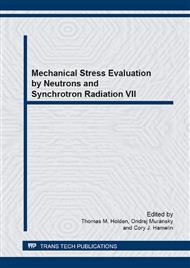p.1
p.7
p.12
p.19
p.25
p.31
p.35
p.40
Study of Microstructure, Texture and Residual Stress in Asymmetrically Rolled Titanium
Abstract:
Asymmetric rolling is a promising forming technique offering numerous possibilities of material properties modification and the improvement of technological process parameters. This geometry of deformation is relatively easy to implement on existing industrial rolling mills. Moreover, it can provide large volume of a material with modified properties. The study of microstructure, crystallographic texture and residual stress in asymmetrically rolled titanium (grade 2) is presented in this work. The above characteristics were examined using EBSD technique and X-ray diffraction. The rolling asymmetry was realized using two identical rolls, driven by independent motors, rotating with different angular velocities ω1 and ω2. This ensured a wide range of rolling asymmetry: A=ω1/ω2. It was found that a strong shear stress induced in the asymmetrically rolled material allowed to obtain a microstructure refinement, texture homogenization and lowering of residual stress.
Info:
Periodical:
Pages:
1-6
Citation:
Online since:
February 2014
Keywords:
Price:
Сopyright:
© 2014 Trans Tech Publications Ltd. All Rights Reserved
Share:
Citation:


